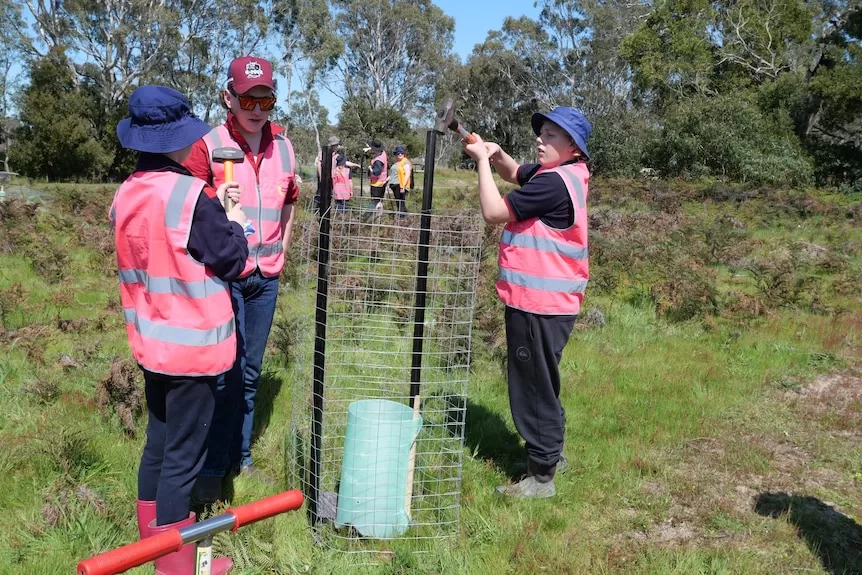Blue gums degraded Victoria’s native wetlands. Red gums are now restoring them.
Walker Swamp in south-west Victoria was a healthy wetland, home to populations of platypus, native frogs, and a dazzling array of waterbirds, along with countless less charismatic but equally vital invertebrate and fish species.
Over two centuries it was flooded, then drained for agriculture, cropped, and ultimately replanted with Tasmanian blue gums for timber harvesting.
Now the blue gums are being removed, replaced by red gums and other plant species indigenous to the area.
Teams of ecologists, volunteers and school children last month surveyed the health of those red gum plantings.
About 400 hectares of commercial blue gum plantation was bought by not-for-profit organisation Nature Glenelg Trust (NGT) about five years with a view to returning Walker Swamp to its natural state.
“It’s not just the fact they are Tasmanian blue gums, it’s how they were grown here,” NGT senior ecologist Greg Kerr said.
“The blue gums were grown as a crop, so you’ve got a monoculture.
He said it was missing a complexity of species spread across the landscape.
“In a [healthy] forest, you have a ground layer, there are wattles and other things growing in a middle layer,” he said.
“And then you’ve got the eucalyptus and things like she-oaks growing in an upper layer.
“That complexity of habitat means a huge range of birds and mammals and reptiles use different elements of the habitat, different components of what’s there.”
In contrast to the plantations, natural blue gum forests — such as those in Gippsland and the Otway Ranges in Victoria, and throughout Tasmania — have as much or more biological diversity as open woodland.
But the blue gums are not an indigenous nor healthy addition to those wetland environments.
They occur naturally in higher rainfall areas and do not thrive in a flood plain environment.
“When [plantations] were established across this site, they planted blue gums right across all of the wetlands, as well as all the dry areas,” Dr Kerr said.
“That meant that many of the trees that had been planted died when the wetlands filled periodically in the first few years.”
He said mounds and furrows which raised the blue gums seedlings about 15 to 20 centimetres were built in long rows about five metres apart.
“A difference of a centimetre or two can make a big difference to what’s inundated and has huge impacts on the functioning of the wetland,” he said.
Dr Kerr said restoring the natural, flatter landscape base had been a slow, expensive process, costing up $3,700 per hectare.
He said it would take 10 to 15 years to get rid of the remainder of the stumps and kill off regrowth.
Community effort
NGT has worked with researchers, Friends of the Forgotten Woodland volunteers and students from several Victorian Western District schools to make improvements and monitor the health of red gum plantings since 2022.
Community coordinator Lisa McIntyre said teams typically consisted of an adult volunteer and a few students from Good Shepherd College and Parkland Special Development School.
“They come out to visit Walker Swamp and get to know each other,” Ms McIntyre said.
“They’ve planted trees, designed a walking track and researched the plants and animals living there.
“It’s such a beautiful project because these kids who might not necessarily come across each other in regular life got to know and work with each other.”
Eucalyptus varieties
The differing impacts red gums and blue gums have on a wetland illustrate how diverse the eucalypt family is.
There are nearly 1,000 different varieties according to the CSIRO, and not all are “gum trees”: a term which usually refers to those eucalypts with smooth bark.
ABC gardening presenter and horticulturist Rob Pelletier said identifying eucalypt varieties was challenging due to their similarity in appearance, but also hybridisation between species.
These are a dozen of his most significant varieties.
River Red Gum (Eucalyptus camalduldensis) – one of the widest distributed, longest lived, largest, and most stately of eucalyptus trees. Often found along waterways.
Blue Gum (Eucalyptus globulus) – commonly known as Tasmanian blue gum, naturally occurs in Victoria such as in the Otways. Juvenile blue gum leaves are broad and roundish with a bluish colour.
Grey Box/Yellow Box (Eucalyptus macrocarpa/melliodora) – yellow box is famous for it’s honey. Similar range but yellow box tends to be in slightly wetter areas.
Red box (Eucalyptus polyanthemos) – smaller than other box trees and naturally occurs in NSW tablelands and tolerates poor soils. Juvenile foliage is grey but adult foliage is green.
Manna Gum (Eucalyptus viminalis) – leaves are food source for koalas, and gum is a source of sweetness. Endemic to south-eastern Australia. Varies greatly in height depending on environment. Bark is stringy and peels off.
Sugar Gum (Eucalyptus cladocalyx) – important firewood and shelter species, widely planted by European settlers. Tall with a smooth multicoloured bark, and less dense foliage than other gum trees.
Peppermint Gum (Eucalyptus dives/radiata/nicholii) – several species named for aromatic, menthol-scented foliage.
Lemon-scented Gum (Corymbia citriodora) – smooth and white trunk, and can grow very large. Named for its long, narrow, citrus-scented foliage.
Snow Gum (Eucalyptus pauciflora) – an elegant tree, endangered by livestock and brumbies. Usually the last tree going up in elevation. Smaller at higher elevation than at lower. Smooth bark tree with striations of grey, white and other colours.
Ghost Gum (Corymbia aparrerinja) – the iconic outback tree with “ghostly” white bark, painted by great Australian artists. Formerly classified as Eucalyptus papuana.
Stringybark (Eucalyptus oblonga, obliqua and related species) – a problem in fire-prone areas as their loose, fibrous bark is flammable and creates embers. Messmate (Eucalyptis obliqua) is a variety of stringybark.
Red-flowering Gum (Eucalyptus Ficifolia) – widely cultivate and bred by horticulturalists. Easily identified by spectacular flowers ranging from salmon pink to rich red.
Get our local newsletter, delivered free each Wednesday
